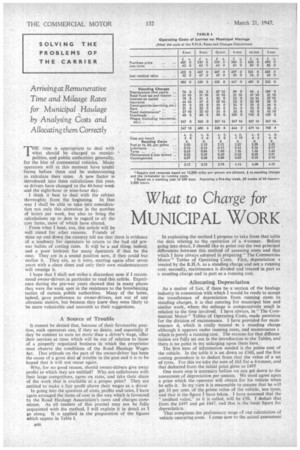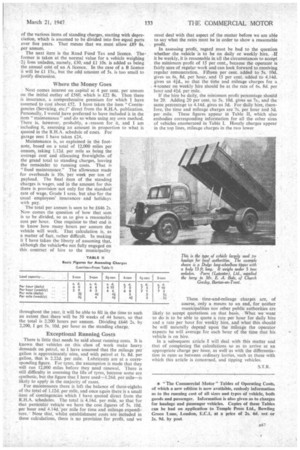What to Charge for
Page 52

Page 53

If you've noticed an error in this article please click here to report it so we can fix it.
MUNICIPAL WORK
Arriving at Remunerative Time and Mileage Rates for Municipal „Haulage by Analysing Costs and Allocating them Correctly THE time is appropriate to deal with what should be charged to municipalities, and public authorities generally, for the hire of commercial vehicles. Many operators will at this moment have tender forms before them and be endeavouring to calculate their rates. A new factor is introduced into these calculations this year, as drivers have changed to the 44-hour week and the eight-hour or nine-hour day.
I think it best to deal with the subject thoroughly from the beginning. In that way I shall be able to take into consideration not only this alteration in the number of hours per week, but also to bring the calculations up to date in regard to all the cost items, most of which have altered.
From what I hear, too, this article will be well timed for other reasons. Friends of
mine up and down the country tell me that there is evidence of a tendency for operators to return to the bad old prewar habits of cutting rates. It will be a sad thing, indeed, and a poor lookout for many Operators if that be the case. They are in a sound position now, if they could but realize it. They are, as it were, starting again after seven years with a clean sheet and only their own misdemeanours will smudge it.
I hope that I shall not strike a discordant note if I recommend owner-drivers in particular to read this article. Experience during the pre-war years showed that in many places they were the weak spot in the resistance to the browbeating tactics of certain public authorities. Many of the latter, indeed, gave preference to owner-drivers, not out of any altruistic motive, but because they knew they were likely to be more vulnerable and succumb to their suggestions.
A Source of Trouble
It cannot be denied that, because of their favourable position, such operators can, if they so desire, and especially if they be content to earn no more than a driver's wage, offer their services at rates which will be out of relation to those of a properly organized business in which the proprietor must observe the conditions of the Road Haulage Wages Act. That attitude on the part of the owner-driver has been the cause of a great deal alf trouble in the past and it is to be hoped that it will not occur again.
Why, for no good reason, should owner-drivers give away profits to which they are entitled? Why not collaborate with their large competitors, agree on rates, and take their share of the work that is available at a propel price? They are entitled to make a fair profit above their wages as a driver
In going into the question of costs, profits and rates, I have again arranged the items of cost in the way which is favoured by the Road Haulage Association's rates and charges committee, As all readers of this journal may not be fully acquainted with the method, I will explain it in detail as I go along. It is applied in the preparation of the figures which appear in Table 1. In explaining the method I propose to take from that table the data relating to the operation of a 4-tonner.. Before going into detail, I should like to point out the two principal differences between this method of assessing costs and that which I have always adopted in preparing "The Commercial Motor" Tables of Operating Costs. First, depreciation s treated by the R.H.A. as a standing charge and not a running cost; secondly, maintenance is divided and treated in part as a standing charge and in part as a ninning cost.
Allocating Depreciation
As a matter of fact, if there be a section of the haulage industry in connection with which I would be ready to accept the transference of depreciation from running costs to standing charges, it is that catering for municipal hire and similar work, where the mileage is comparatively small in relation to the time involved. I have always, in " The Commercial Motor" Tables of Operating Costs, made provision for the division of maintenance. I have provided for maintenance d, which is really treated vs a standing charge although it appears under running costs, and maintenance e which is purely a running cost. The reasons for that differentiation are fully set out in the introduction to the Tables, and there is no point in my enlarging upon them here. The first item of information needed is the prime cost of the vehicle. In the table it is set down as £560, and the first costing procedure is to deduct from that the value of a set of tyres. For this we take the sum of £63 for a 4-tonner, and that deducted from the initial price gives us £497
One more step is necessary before we can get down to the assessment of depreciation per annum. We must agree upon a price which the operator will obtain for his vehicle when he sells it. In my view it is reasonable to assume that he will get 10 per cent. of the prime value of the vehicle, less tyres, and that is the figure 1 have taken. I have assumed that the residual value," as it is called, will be £50. I deduct that from the £497 and get £447, and that is the basic figure foi depreciation. That completes the preliminary stage of our calculation of vehicle operating costs. I come now to the actual assessment of the various items of standing charges, starting with depreciation, which is assumed to be divided into five equal parts over five years. That means that we must allow. £89 8s. per annum. • The next item is the Road Fund Tax and licence. Theformer is taken at the normal value for a vehicle weighing .2i fons unladen, namely, £30, and £1 10s. is added as being the annual c.,:ist of an A licence. In the case of a B licence it will be £1 15s., but the odd amount of 5s. is too small to justify discussion.
Where the Money Goes
• Next comes interest on capital at 4 per cent per annum on the initial outlay of £560, which is £22 8s. Then there
is insurance, a comprehensive premium for which I have assumed to cost about £52. I have taken the item "Contingencies (Servicing, etc.)" direct from the R.H.A. publication.
Personally. I would have preferred to have included it in the item " maintenance " and do so when using my own method. There is, however, probably, a treason for it, and I am including it, assessing an amount in proportion to what is quoted in the R.H.A. schedule of costs. For garage rent I have taken £24.
Maintenance is, as explained in the footnote, based on a total of 12,000 miles per annum taking 1.12d. per mile as being the average cost and allocating five-eighths of the grand total to standing charges, leaving the remainder to running costs. That is "fixed maintenance." The allowance made for overheads is 10s. per week per ton of payload. The final item of the standing charges is wages, and in the amount for this there is provision not only for the standard rate of wage, Grade I area, but also for the usual employees' insurances and holidays with pay.
The total per annum is seen to be £646 2s. Now comes the question of how that sum is to be divided, so as to give a reasonable cost per hour. One requisite to that end is to know how many hours per annum the vehicle will work. That calculation is, as a matter of fact, rather difficult. In making it I have taken the liberty of assuming that, although the vehicle•be not fully engaged on this contract of hire to the municipality throughout the year, it will be able to fill in the time to such an extent that there will be 50 weeks of 44 hours, so that the total is 2,200 hours per annum. Dividing £646 2s. by 2,200, I get 5s. 10d, per hour as the standing charge.
Exceptional Running Costs
There is little that needs be said about running costs. It is known that vehicles on this class of work make heavy demands on petrol, so I have assumed that the mileage per gallon is approximately nine, and with petrol at Is. 8d. per gallon, that is 2.22d. per mile. Lubricants are at a corresponding figure. For tyres, the assumption is made that they will run 12,000 miles before they need renewal. There is still difficulty in assessing the life of tyres, because some are synthetic, but the figure that I have used-1.26d. per mile-is likely to apply in the majority of cases,
For maintenance there is left the balance of three-eighths of the total of 1.12d. per mile, and once again there is a small item of contingencies which I have quoted direct from the R.H.A. schedules. The total is 4.14d. per mile, so that for that particular vehicle we have the cost figures of 55. 10d. per hour and 4.14d.'per mile for time and mileage, expenditure.-Note that, whilst establishment costs are included in these calculations, there is no provision for profit, and we
must deal with that aspect of the matter before we are able to say what the rates must be in order to show a reasonable profit.
In assessing profit, regard must be had to the question whether the vehicle is to be on daily or weekly hire. -if it be weekly, it is reasonable in all the circumstances to accept the minimum profit of 15 per cent., because the operator is fairly sure of regular work and can look forward to receiving regular remuneration. Fifteen per cent. added to 5s. lad. gives us 6s. 8d. per hour, and 15 per cent, added to 4.14d. gives us 40., so that the tirae and mileage charges for a 4-tanner on weekly hire should be at the rate of 6s. 8d. per hour and 4id. per mile.
If the hire be daily, the minimum profit percentage should be 20. Adding 20 per cent. to 5s. 10d. gives us 7s., and the same percentage to 4.14d. gives us 5d. For daily hire, therefore, the time and mileage charges are 7s. per hour and 5d. per mile. These figures appear in Table II, which also embodies corresponding information for all the other sizes of vehicles enumerated in Table I. Hourly charges appear in the top lines, mileage charges in the two lower
These time-and-mileage charges are, of course, only a means to an end, for neither municipalities nor other public authorities arelikely to accept quotations on that basis. What we 'want to do is to be able to quote a rate per hour for daily hire and a rate per hour for weekly hire, and what this should be will naturally depend upon the mileage the operator expects he will average for each hour of the time that his vehicle is on hire.
In a subsequent article I will deal with this matter and that of completing the calculations so as to arrive at an appropriate charge per hour, as well as with the differentiation in rates as between ordinary lorries, such as those with which this article is concerned, and tipping vehicles.
5+
S.T.R.












































































